Abstract
This article presents multidisciplinary research that involved design (i.e., textiles, tiles, pattern design), mathematics (i.e., symmetry and seven frieze groups) and a viewpoint on product design and development for business opportunities. This research comprised a design experiment and a survey. In the design experiment, two design approaches were created to translate the characteristics of traditional textile patterns into new pattern designs for floor tiles. These two design approaches were entitled: “partial replication”, and “combination and simplification”. The seven frieze groups were used as a transformation rule in both design approaches, resulting in two sets of frieze patterns. Although they were derived from the same origin, they looked different. A survey was conducted with 61 respondents to gain outsiders’ perspectives on these new pattern designs. The findings include: (i) positive responses to applying traditional textile patterns to other products, (ii) plausible products for pattern designs, (iii) preferences for design approaches and frieze patterns and (iv) opportunities for design research and education with other disciplines. This paper concludes with theoretical and practical implications for further research.
1. Introduction
This article presents multidisciplinary research that involved design (i.e., textiles, tiles, pattern design), mathematics (i.e., symmetry and seven frieze groups) and a viewpoint on product design and development for business opportunities. This research was initiated by us as we have a common interest in pattern design in relation to cultural adherence, continuity and change. Chudasri is a design researcher who has been researching indigenous woven textiles in Thailand and has recently applied visual and symmetrical analysis in design research to examine traditional textile patterns [1,2]. In the long run, Chudasri intends to develop design methods and digital tools that invigorate cultural revitalization. Kunkhet is a design researcher specializing in shape grammar and character design for 3D animation. Previously, we developed a framework for Harmonized Shape Grammar (HSG) that was applied to a real case study, namely a specific context in which traditional textile patterns were regenerated [2]. It was a design process that involved symmetry analysis, i.e., seven frieze groups. Having conducted that, we realised that this mathematical theory also enabled us to design a variety of new patterns, which were not limited to textile patterns. Designers often begin their creative work by searching for information and redesigning successful elements from preceding collections, e.g., traditional textiles and tiles [3]. In this article, we conducted a design experiment in which the characteristics of traditional textile patterns were translated through a design process into pattern designs for floor tiles. We also developed two design approaches, both of which involved seven frieze groups that could generate a variety of new patterns for floor tiles. Finally, we conducted an online survey with 61 respondents in order to gain outsiders’ perspectives on the design approaches to invigorating cultural significance.
2. The Core Components
2.1. Traditional Patterns and Design Structure of “Sin Tin Chok”
The word “pattern” in this research context refers to a decorative design. A pattern involves the repetition of a motif, or motifs, at regular intervals using rigid motions to fill a flat surface [3,4] (p. 1). “Motifs are any kind of figure, image or illustrative drawing, produced by artists or graphic designers” [3]. Motifs may be either symmetrical or asymmetrical. A symmetrical motif is a figure which is comprised of two or more units of identical size, shape and content [4] (p. 1). Traditional patterns are those considered by indigenous informants to have been produced for several generations by using similar techniques, and those patterns have not undergone significant change even when they have been produced in recent times [5] (p. 581). In any specific cultural group, the people will consistently use specific symmetries and design structures in their cultural design systems [4] (pp. 2, 8, 55), e.g., the patterns in “sin tin chok” from Long district, Phrae province in northern Thailand (Figure 1). Handwoven textiles and cloth-making are meaningful to the Long people, who recognise these as an intangible cultural heritage. “Sin tin chok” was originally designed to comprise three parts: a waistband, a body section and a lower section. Its lower section (“tin chok”) is a woven fabric comprising frieze patterns (Figure 1: right). “Tin chok” is designed to have four parts: a supplementary part, a main part, a supplementary part and a hem (Figure 1: right). We referred to these four parts as “a pattern set”. It is a set of four frieze patterns placed in “tin chok” according to this design structure.
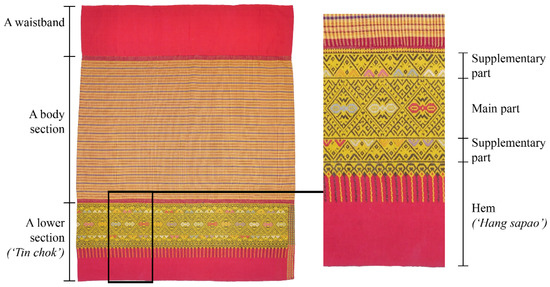
Figure 1.
“Sin tin chok” from Komol Phaboraan Museum, Long district, Phrae province. (Photo by Chudasri).
2.2. Textile Patterns and Tiles
Textile patterns and tiling with tiles share a similar practice, by which motifs/units are regularly repeated on a flat surface [3]. Tiling is the regular repetition of tiles with defined geometric forms without gaps or overlaps between them [3]. In the last two decades, a number of scholars have researched previous collections of tiles and textile patterns, with attempts to understand and describe the structural designs of patterns and tiling, and developed methods, systems and tools for use in redesigning textiles and tile patterns [3,6,7,8]. There is the possibility in the design process to integrate both types of patterns and interchange their characteristics. A tile is a flat piece of hardened material, such as baked clay or stone, that is used for covering a wall, floor or roof [9]. In building construction, tiles can be classified into two main types: wall tiles and floor tiles. Floor tiles are produced from stronger materials than wall tiles. Floor tiles are important materials in building construction and floor decoration [10]. Tiles can be designed in various geometric shapes such as squares, rectangles, diamonds and hexagons. However, a square is seen as a standardised tile shape [11]. A tile shape can inform the tile layout. A layout is an arrangement of diverse units [12]. For example, Figure 2 depicts a square tile that can be arranged in five different layouts: grid/stacked, checkerboard, diagonal/diamond, old English and hopscotch [13]. A tile layout is used as a guide to divide and organise a space and inform the quantity of tiles required for the space.

Figure 2.
A square tile arranged in various layouts. (Illustration by Kunkhet).
2.3. Frieze Patterns and Seven Frieze Groups
Frieze patterns can be found in many places and products such as architecture, pottery, handwoven textiles and embroidered patterns on clothes. In mathematics, a frieze pattern is a two-dimensional image (with width and length) identified with a motif that is repeated at regular intervals in one direction (e.g., in a horizontal direction) across a flat surface. Every symmetric motif consists of at least two asymmetric units of the same size, shape and content [4] (pp. 1–2). All frieze patterns can be classified into seven groups based on their symmetries [14] (pp. 44, 58–59, 83), [15] (pp. 24–27), [16]. These are known as the seven frieze groups. A frieze pattern is generated as a result of the movement of the original motif using rigid motion(s) on a flat surface in one direction [15] (p. 24). A rigid motion is a transformation of a flat surface where the original motif and its image are congruent in size, shape and content [17] (p. 159). There are four kinds of rigid motions: translation, twofold rotation, reflection and glide reflection, which can generate any pattern [15] (p. 24), [16,17] (p. 159). All frieze patterns necessarily contain translations, but they may or may not contain twofold rotations, reflections or glide reflections. Figure 3 depicts four rigid motions and seven frieze groups. There are many naming systems for frieze groups besides a notable group from a scientific union, i.e., the International Union of Crystallography (IUCr) [18]. Here, we referred to the crystallographic symbols of Washburn and Crowe [14] to classify the seven frieze groups. However, we also compared this naming system to the IUCr, as shown in Figure 3.
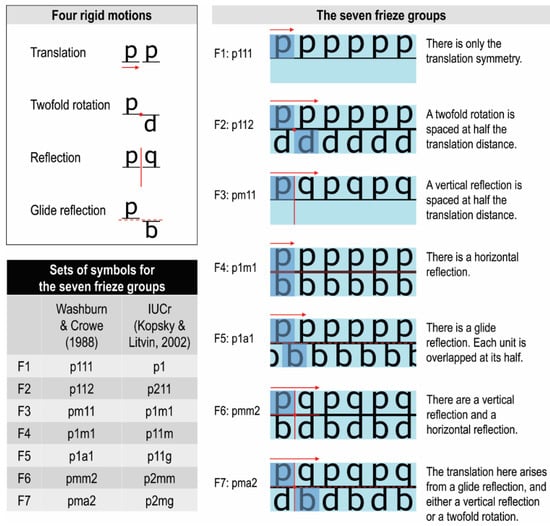
Figure 3.
Seven frieze groups. Red arrows indicate translation distance. Red lines indicate axes of symmetry (horizontal and vertical). Dashed red lines indicate horizontal glide reflection axes of symmetry. Red dots indicate twofold rotation axes in each part. (Illustration by Kunkhet and Chudasri).
3. Research Methodology
The pattern sets in “tin chok” are frieze patterns, as these patterns are two-dimensional designs that are woven incrementally along the warp threads of a loom, so the fabric’s length increases in one direction [1]. We aimed to design the tile patterns by taking inspiration from the traditional textile patterns in “tin chok”. Here we posed a question: how can the traditional textile patterns in “tin chok” be translated into tile patterns? In this design experiment, we narrowed down the research scope to embrace three conditions. We applied the seven frieze groups as a set of transformation rules in the design process. A square was the only tile shape in this design experiment because it is a standardised tile shape, and several motifs in “tin chok” are identified as square or rectangular shapes. A grid/stacked layout is the only arrangement of tiles that we employed to place square tiles on a flat surface. The research methodology comprised two phases: the design process and the online survey of design derivations because we wanted to gain outsiders’ perspectives (Figure 4). In business and marketing, the terms “inside-out” and “outside-in” refer to opposite strategies for creating value for customers and achieving success [19].
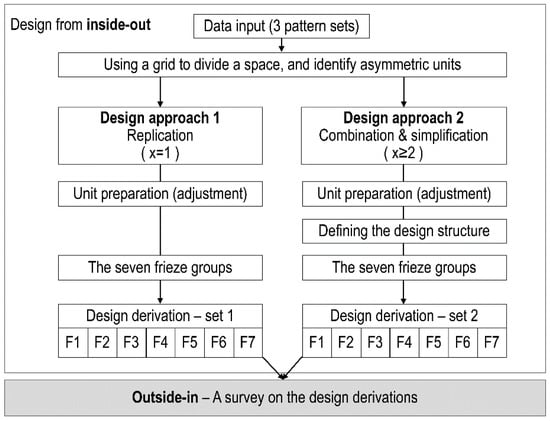
Figure 4.
Research methodology. (Illustration by Kunkhet and Chudasri).
3.1. Design Process
In the first phase, our design process was an inside-out strategy that only embraced the designers’ perspectives. We discussed an idea, related it to our previous research [1,2,20,21] and worked out this design experiment together from our internal resources, including a pattern booklet, capabilities and strengths. This pattern booklet (54 pages) was digitally created by Chudasri’s research group in 2018 [20,21]. It displays original photographs of the 17 vintage (traditional) skirts that are exhibited in Komol Phaboraan Museum, their patterns in the hems and a replication of the 17 pattern sets shown with pixels. There was a request for decoding and visualizing these pattern sets on graph paper because these would help weavers to identify the number of threads and create the pattern elements. A graph paper is made up of fine lines that are arranged vertically and horizontally as to create many small blocks. These are comparable to (i) the interlacing of warp threads and weft threads that create pattern elements of a fabric and (ii) individual pixels in a digital picture.
The information in the original photographs of the 17 pattern sets was manually decoded and digitally recorded in computer software, i.e., Excel and Photoshop. In Excel, the column width and row height were adjusted to the smallest number (1 × 1) so that every cell represented each of the individual pixels in a picture. One could fill information in any cell (or pixel) with respect to the original patterns. This fairly small size (1 × 1) of individual pixels could conform to any shape and size of pattern elements, no matter how small or large their shapes were. Next, the pattern elements were copied to Photoshop in order to create a new file. Regarding the image quality (high or low resolution), it was necessary to “preset details” of the file at the beginning, i.e., the canvas size (e.g., 21.0 × 29.7 cm, equal to the size of A4-paper) and image resolution (e.g., 300 pixels/inch). For high-quality images, we recommend setting an image resolution for at least 300 pixels/inch at the actual size by which such information will be displayed in print, such as on A4-paper. With this setting, if such an image has to be displayed on a digital screen, it is going to be fine because a digital screen usually requires a lower resolution, e.g., 72 pixels/inch. Consequently, we obtained raster images that were save as JPG, PNG, PSD or TIFF file formats.
This method to replicate information from the original photographs is similar to a creation of pixel art. There are strong similarities between pixel art and traditional restrictive art forms, such as mosaics, cross stitch and weaving. Pixel art is commonly used in computer game development to virtually create characters or other assets in the game [22,23]. Pixel art is a form of digital art that uses computer software to create the restrictive number of pixels to form a digital picture. Such a picture may be created by different methods, such as a photograph from a digital camera and an image created by computer software. A pixel means a picture element, and it is the smallest unit of information that makes up a picture. Every pixel contains certain information that contributes to create the meaning of the whole picture [24]. In a picture, a certain shape of pixels is usually applied throughout, for example round or square. In this design experiment, we used square pixels.
Among the 17 pattern sets, we selected three pattern sets for this design experiment (Figure 5). The three images in the upper part of Figure 5 are the original photographs of the fabric patterns, whereas the other three images in the lower part were generated by computer software (explained above). Note that the three images generated by computer software have a minor difference from the original photographs. That is, the four parts of each pattern set (the supplementary part, main part, supplementary part and hem) have a common vertical reflection axis [1]. In the original photographs, the vertical reflection axes of the main part were not aligned with the two supplementary parts and the hem. Alterations to the vertical reflection axes represent a weaving method that the Long weavers employ at the present time [1].
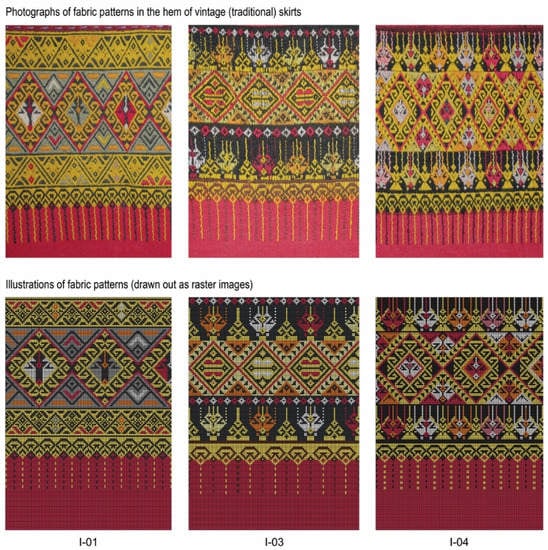
Figure 5.
Three pattern sets shown with original photographs and computer-generated images (images from Chudasri).
By magnifying the three original photographs (Figure 5, the upper part), one can see the many threads that form the pattern elements, such as triangles and diamonds, which can be identified by the different colours of threads. It is obvious that the edges of the pattern elements are not smooth. Regarding the replication of information from the original photographs, one may ask why not use a vector graphic software to draw the outlines of these pattern elements as geometric shapes so that their edges are smoothened. We preferred not to do so as it is obvious that the edges of these patterns in real fabrics are not smooth. In this design experiment, we avoided any loss of information; therefore, we retained the pixelated characteristics and directly translated them into the design of tile patterns.
To construct or deconstruct two-dimensional designs on a flat surface, a designer should consider the space distribution and the relationship between grid and space [12] (p. 46). According to Josef Müller-Brockmann, as cited in [12] (pp. 35–36), a grid is a visual organization tool, which many designers use for organizing the design elements in a space. So, the design elements are presented with clarity and purpose. Relative to graph paper and the individual pixels of a picture, a grid is an arrangement of orthogonal lines that cross each other to form a network of identical squares or rectangles [12] (p. 35). Josef Müller-Brockmann, as cited in [12] (p. 46) suggests using a grid to divide a two-dimensional surface into smaller fields. Hence, we created a grid on each pattern set in order to identify asymmetric units and select the units for the design experiment. We also created two design approaches, in which these units could be translated to form tile patterns. We named these two design approaches (i) partial replication and (ii) combination and simplification. In design approach 1, only one asymmetric unit was replicated in a square, to which seven frieze groups were applied (Figure 6). This resulted in seven frieze patterns (Figure 7) (explained further in Section 4). In design approach 2, more than one asymmetric unit was selected for the design development where, the unit placement was confined to a square (Figure 8). In this square, a design structure was drawn out as guideline for the placement of the selected units, combining them and simplifying their elements (Figure 9). This resulted in a newly designed unit, which was used to generate the tile patterns (Figure 10) (explained further in Section 5). As a result of the entire design process, two sets of seven frieze patterns were illustrated (Figure 7 and Figure 10). Although they were derived from the same origin, they looked different.
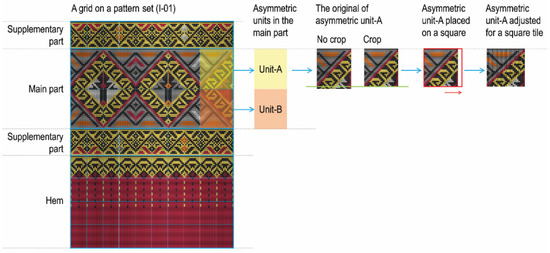
Figure 6.
Asymmetric units and adjustments on a square tile. (Illustration by Kunkhet and Chudasri).
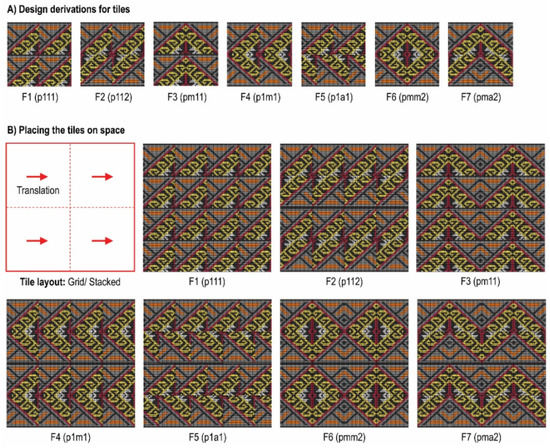
Figure 7.
Design derivations from ‘design approach 1’. F1–F7 represent sets of symbols for the seven frieze groups as indicated in Figure 3. Red arrows indicate tile placement in a horizontal orientation, similarly to translation. (Illustration by Kunkhet and Chudasri).
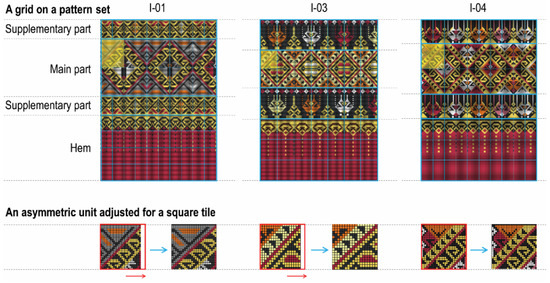
Figure 8.
Asymmetric units from three main parts and adjustments on square tiles. Red arrows indicate stretching in a horizontal orientation. Blue arrows indicate the unit adjustments or compliance to the square. (Illustration by Kunkhet and Chudasri).
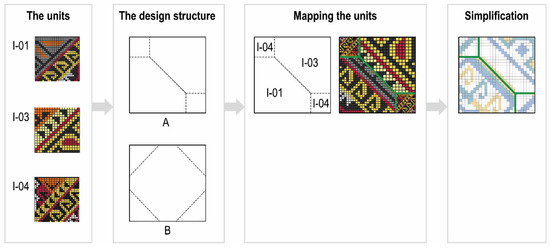
Figure 9.
Mapping asymmetric units in the design structure, followed by simplification. (Illustration by Kunkhet and Chudasri).
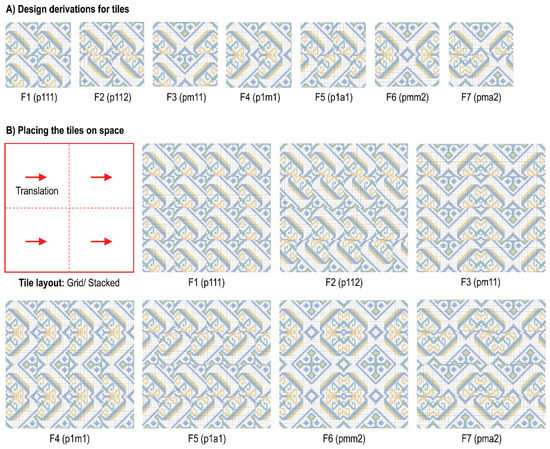
Figure 10.
Design derivations from ‘design approach 2’. F1–F7 represent sets of symbols for the seven frieze groups as indicated in Figure 3. Red arrows indicate tile placement in a horizontal orientation, similarly to translation. (Illustration by Kunkhet and Chudasri).
3.2. Online Survey
We intended to show to the public how the characteristics of traditional textile patterns can be translated into square tile patterns. We also hope that this design experiment will be useful for creating valuable products that are attractive to customers and raising awareness of design for cultural significance. Therefore, in the second phase, we conducted a survey with focus groups in order to gain customers’ perspectives, including their preference between these two sets of design derivations. This was an outside-in strategy, which can lead to greater customer satisfaction [19]. The Thai focus groups included designers and undergraduate students (in textile design, graphic design and product design) and members of enterprises. In one week, we achieved 61 Thai respondents in total (Figure 11). This survey comprised two parts: the respondents’ general information and their perspectives on pattern designs. Enquiries into their general information included gender, age, occupation, hometown and current province of residence. Their personal identities remained anonymous. There were seven questions in the second part. Survey question 1: what do you think about traditional textile patterns in design being applied to other products? Survey question 2: from the images of traditional textile patterns (Figure 5), please suggest at least three products to which these textile patterns can be applied to redesign them? Please note that in the survey questions that follow, the images of pattern designs were presented as greyscale images. This enabled the respondents to focus on the design elements in patterns rather than their different colour schemes. Survey question 3: which design approach (1 or 2) do you prefer? Respondents had to view two images (Figure 12) before selecting one. By selecting their preferred approach (Figure 13), survey question 4 presented a relevant image that showed seven frieze patterns (Figure 14 or Figure 15). The respondents were asked to choose up to three design options from amongst the seven, i.e., which option do you like? Survey question 5 asked the respondents to explain their reasons for choosing such a design approach and design options. Survey question 6 asked: do you know that two-dimensional patterns that are designed to repeat in one direction (such as tiles for interior decoration and textile patterns) can be classified based on their symmetry into “the seven frieze groups”? Survey question 7 asked if the respondents could suggest other methods for pattern design.
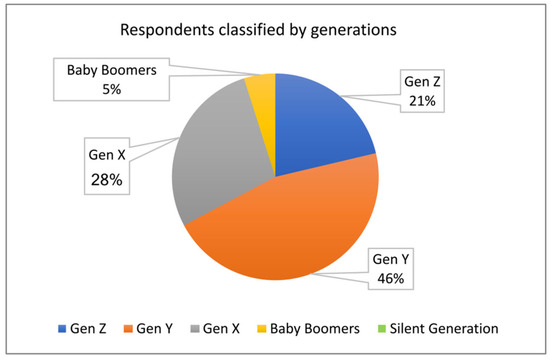
Figure 11.
Numbers of respondents classified by generation, shown in percentage.

Figure 12.
Two design approaches for selection. (Illustration by Kunkhet).

Figure 13.
Percentage of respondents’ preferences for two design approaches.

Figure 14.
Design approach 1: seven frieze patterns and respondents’ preferences. (Illustration by Kunkhet and Chudasri).
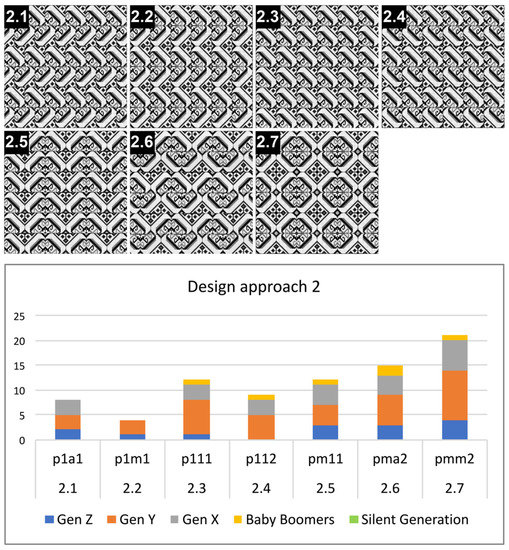
Figure 15.
Design approach 2: seven frieze patterns and respondents’ preferences. (Illustration by Kunkhet and Chudasri).
4. Design Approach 1: Partial Replication and Design Derivations
Design approach 1 was intended to replicate an asymmetrical unit identified from a pattern set and place it on a flat surface to create patterns on square tiles. We selected pattern set I-01 for demonstration purposes (Figure 6). In the design structure of “tin chok”, the pattern in the main part is more dominant than the other three parts. So, we focused on the main part and identified two asymmetric units that were Unit-A and Unit-B, as shown in Figure 6. For the design development, a new square was needed for placing an asymmetrical unit, and we selected Unit-A for demonstration. Prior to placing an asymmetrical unit in the square, we may or may not have had to crop a boundary of an asymmetrical unit. Here, we cropped the bottom of Unit-A in order to make its height the same as the side of the square. Likewise, the width of Unit-A was not the same as the side of the square. So, we stretched the width of Unit-A to have the same distance as the side of the square. By doing so, we were aware that the “pixel aspect ratio” (PAR) of 1:1 was not preserved. The other reasons that we took into consideration were as follows. This stretch was fairly short, i.e., a distance of less than seven percent of the side of the square, which did not disturb visual characteristics of Unit-A. There was a considerable resemblance between the shape elements of the original and the adjustment of Unit-A; for example, their straight lines and directions, triangles and trapezoids. Without a mandate that every feature of shape elements must be exactly preserved, designers can freely think and come up with a creative approach that deals with a given context and thereby a design development. Consequently, the square was wholly filled up with shape elements, i.e., the adjusted Unit-A in Figure 6, which was ready for further design development at this point.
Next, the seven frieze groups were applied to the adjusted Unit-A as a set of transformation rules (Figure 3) to generate frieze patterns. There were the seven design derivations of patterns for the square tiles (Figure 7A). These patterns were ready for tiling. Amongst the several tile layouts (Figure 2), we chose a basic layout—grid/stacked—to experiment further. With this selected layout, individual tiles can be arranged in different orientations, and this will result in different tile patterns that can be repeated all over a flat surface [13] (p. 2). We were aware of this, but we preferred to placing the same individual tiles at the same distance in the same orientation all the way across a flat surface because this is convenient for builders in practice. This orientation is described as “translation” (p111) according to the four rigid motions (Figure 3). Figure 7B depicts the placements of individual tiles by translation in a space. It is noted that we also applied 90-degree rotations as different orientations of individual tiles that created different tile patterns across the space. However, in our opinion, doing so would be rather confusing for builders in practice. It would be better if such a creation was completed in the design process, for example by adjusting the tile size or dividing the space into four units using orthogonal lines.
5. Design Approach 2: Combination and Simplification—And Design Derivations
Design approach 2 was intended to combine more than two asymmetrical units in a design structure and simplify their elements to create new patterns for square tiles. We applied this concept to three pattern sets, namely I-01, I-03 and I-04, which were overlaid by grids (Figure 8). Similar to design approach 1, we focussed on patterns in the main part and identified asymmetrical units (overlaid with yellow squares or rectangles) for the design development. A new square was needed for placing the asymmetric units. It is obvious that asymmetric units identified with rectangles have only one side that fits with a square. In this experiment, the width of the rectangles was stretched to have the same distance as the side of the square. This means that the PAR of 1:1 of the original units was not preserved; however, we accepted such an adjustment with good reason (explained in Section 4). Consequently, there were three asymmetrical units resulting from the same size of the square. Yet, they comprised different sizes of square pixels: 25 × 27, 18 × 19 and 27 × 26 pixels, respectively. These were not that big issue for the design at the moment (explained below), and at this point they were ready for further design development.
The next step was to create another new square for the design structure. A design structure is the way in which the parts of something are organised or arranged into a whole or the way in which something is divided into parts. In this experiment, lines were drawn in this new square to represent the design structure. This was used to guide a combination of asymmetrical units and design elements in order to design new tile patterns. It is noted that the design structure was different from the shapes of the tiles (e.g., square, rectangle) and tile layouts (e.g., grid/stacked, checkerboard). The basic information about a design structure resides in three features: a fundamental parallelogram (FP), the design symmetry axes (DSA) and the design of rotational centres (DRC) [3] (p. 499). We conducted a visual analysis of tile patterns shown on commercial websites and observed their graphic elements in relation to a fundamental parallelogram, symmetry axes and rotational centres in the overall design. Eventually, we created two design structures (A and B), and we chose design structure A for the experimentation (Figure 9).
With the three adjusted units (I-01, I-03 and I-04, shown in Figure 9), we intended to combine and simplify their intricate elements in a way that their distinct visual characteristics were retained. As we placed the three adjusted units on the divided areas of design structure A, the different numbers of pixels in the square were not a critical issue. We also rotated, reduced or enlarged the sizing of these three units to ensure that their distinct characteristics remained in the whole design. These three units became different in size, but this was not a critical issue either. This was because in the next step there was a simplification process, in which we applied a grid to divide the whole design space to comprise 27 × 27 pixels and used it as a guideline to simplify the intricate elements. (Twenty-seven was the maximum number identified from the units after cropping or stretching). Finally, the intricate elements were simplified by retaining their distinctive lines and shapes, removing several detailed elements, adjusting parts of the lines or shapes and correlating them with the whole design. Additionally, we applied a new colour scheme to the new design unit so that it was different from the original patterns.
Next, seven frieze groups were applied as a set of transformation rules to the newly designed unit to generate frieze patterns. This process was the same as for design approach 1. Figure 10A depicts the seven design derivations. Furthermore, we arranged these tile patterns in a space in the same way as for design approach 1. Figure 10B depicts the placement of individual tiles by translation into a space.
6. Survey Findings
Currently, the people in our society can be classified into five generations based on their year of birth. (Their ages inform their generation.) Each generation has an active role in the world marketplace [25]. So, a generational breakdown was part of the data analysis in this paper. This survey comprised 61 respondents aged between 15–76 years. They were from four generations, including Gen Z (iGen or Centennials), Gen Y (or Millennials), Gen X and Baby Boomers (Figure 11). Table 1 shows the numbers of respondents classified by generation and gender identity. Thirteen respondents from Gen Z included undergraduate students (n = 8: textiles, fashion, animation, graphics, information technology), designers (n = 2: fashion, graphics), a school student (n = 1), a software developer (n = 1) and a member of an enterprise (n = 1). Twenty-eight respondents from Gen Y included designers (n = 11: fashion, textiles, graphics, product, packaging, architecture), teachers (n = 5: design, mathematics, etc.), company staff (n = 5: tile retail trade, craft enterprises), business owners (n = 4: software developers, information technology, textiles), a writer (n = 1: art and culture), a scientist (n = 1) and another person (n = 1). Seventeen respondents from Gen X included designers (n = 8: industrial design, fashion, textiles, ceramics, interior, branding, packaging, graphics, advertising), business owners (n = 4: art and crafts, textiles, real estate, etc.), teachers (n = 2: visual arts), traders (n = 2) and another person (n = 1). Lastly, there were three respondents from the Baby Boomers (one teacher, one designer and one business owner).

Table 1.
Numbers of respondents classified by generation and gender identity.
6.1. Positive Responses to Applying Traditional Textile Patterns to Other Products
This section responds to survey question 1. Every respondent gave a positive response to the concept of applied design that extends traditional textile patterns to other products. In short, they said I “agree” or “support” this idea, or this is “good” or “interesting”. Their overall responses suggested that this design concept could foster the preservation of traditional textile patterns while also generating new product designs that are suitable for people in the present era. They were favourable to products designed in a contemporary style, i.e., those that were trendy or modern. Around half of the respondents elaborated further. The explanations from the respondents aged between 15–26 (Gen Z) were as follows. “Traditional textile patterns are beautiful, intricate and represent the Thai identity” (ID37, 57). “Design that applies traditional textile patterns to other products can lead to added value, while traditional textile patterns are maintained” (ID43). “It would be good if someone could apply traditional textile patterns to other products that are designed to suit the lifestyles of people at the present time, and it is critical to communicate storytelling to people” (ID31). “Traditional patterns can be adjusted to look more modern [or trendy], and not be restricted to the original image only” (ID33). “This is another way in which traditional textile patterns can remain in Thai society for a long period of time” (ID59). “Traditional textile patterns can inform the identity of local peoples and their geographical areas. By applying traditional textile patterns to other products, people from other areas (outsiders) can have a better understanding of local arts” (ID27). “Local arts will be preserved and known more widely” (ID44).
The explanations from the respondents aged between 27–44 (Gen Y) were as follows. “It is about creating patterns from cultural identity and cultural roots” (ID28, 52). “Design can foster the preservation of traditional arts, which are valuable, through things that are designed for real use in the present time. This will foster adaptation that is suitable to this era. So, traditional art is retained and passed on to the society of the next generations, and there is a variety of designed products” (ID38). “In adopting these applied designs, it concerns the suitability of products and target customers” (ID40). “Design has to be adjusted to suit the present era, and target customers, especially the younger generations” (ID42). “It is good to start from something existing, and extend it further in a way that is suitable for the present time. In this sense, design is fostering cultural preservation, so traditional textile patterns will not disappear or be out of fashion” (ID26). “It is good that cultural capital is used in a design process for creating contemporary products” (ID30). “This is not only to remain local wisdom, but also to extend to new opportunities, including both cultural traditions and business opportunities” (ID16). “It is possible to apply traditional textile patterns to other products, depending on design elements, their size, arrangement and colour schemes. These should conform to the taste and wants of target customers” (ID45). “Traditional textile patterns are an intangible cultural heritage and local wisdom of Thailand. Although creators/designers can apply these patterns to other products, they should respect local wisdom with sincere understanding” (ID49). Explanations from respondents aged between 47–57 (Gen X) are as follows. “This design concept extends the cultural capital to tangible outputs” (ID23). “There will be a variety of products and alternatives for customers” (ID19, 60). “Applying traditional textile patterns to other products is an alternative way to prolong the cultural preservation of traditional textile patterns, and disseminate them to the next generations” (ID22). “This is the preservation of traditional textile patterns that also generates new products that are suitable for the present time” (ID34, 58).
6.2. Plausible Products for Pattern Designs
In survey question 2, the respondents had to view an image that comprised (i) a photograph of Long people wearing traditional skirts for a performance in a traditional ceremony, (ii) a photograph of traditional skirts displayed in Komol Phaboraan Museum and (iii) a picture of three pattern sets generated from computer software (Figure 5, lower part). The respondents were asked to suggest at least three products to which these textile patterns could be applied in order to redesign them. Besides tiles, a variety of products were suggested, including textile products. The new pattern designs may be applicable to dinnerware such as glasses, plates, bowls and placemats. A variety of products for home decoration, such as items in living rooms and bedrooms, were suggested, e.g., curtains, tablecloths, carpets, blankets, bed covers, pillowcases, bed linen, furniture, partitions, wallpaper, vases and paintings. They also suggested clothes and accessories such as skirts, T-shirts, scarves, swimming suits, handbags, shoulder bags, watch straps, shoes, hats, raincoats and long boots. Cases for digital devices can include notebooks, iPads/tablets, mouse pads and mobile phones. Other products included gift wrapping paper and packaging. Additionally, they mentioned production techniques such as printing and painting.
6.3. Preferences for Design Approaches and Frieze Patterns
In the responses to survey question 3 (Figure 12), 27 respondents (44%) preferred design approach 1, while 34 respondents (56%) preferred design approach 2 (Table 2, Figure 13). Although design approach 1 gained a lower number, in our perspective it was not very different. Both design approaches are likely to be successful in terms of design for cultural revitalisation and business opportunities.

Table 2.
Preferences for two design approaches shown with a generational breakdown.
Survey question 4 probed the respondents’ preferences for the seven frieze patterns resulting from the selected design approach (Table 3 and Table 4). Figure 14 and Figure 15 show the seven frieze patterns (from design approaches 1 and 2, respectively) and the respondents’ preferences for these patterns. Overall, they preferred the pattern designs that were connected all-around as a closed path, i.e., a visually larger object. From survey question 5, their rationale for their selection was summarised as follows. The patterns from design approach 1 (partial replication) had some original characteristics that were not changed too much, but these patterns looked trendy or contemporary and could be applicable to other products. These selected patterns showed a continuity, neatness, symmetrical balance and harmony in their designs, which were not too complex or confusing to look at. Similarly, the patterns from design approach 2 (combination and simplification) showed a connectedness and neatness in their symmetrical design. These patterns looked simple and not too complicated. They looked trendy, contemporary and classic as a result of the design layout, design elements and their sizing.

Table 3.
Preferences 1 for frieze patterns from design approach 1.

Table 4.
Preferences 1 for frieze patterns from design approach 2.
6.4. Opportunity for Design Research and Education with Other Disciplines
There are connections between mathematics and design [14] (p. ix), [26]. We demonstrated the use of mathematics, i.e., the seven frieze groups, in the creation of the pattern designs for floor tiles. Likewise, we were curious as to whether people generally knew about this mathematical theory and how deep their knowledge was. From survey question 6, we found that the majority of the respondents did not know about the seven frieze groups, i.e., the classification of infinite discrete symmetrical groups of patterns. Fifty respondents did not know about it at all. Three respondents knew about symmetry, but they did not know how the patterns could be classified or how many symmetry groups there were. Only eight respondents knew about the seven frieze groups. They included a software developer, an entrepreneur, two teachers (maths, visual arts), two designers and two design academics. Knowing this result, we realised an opportunity to educate people, e.g., here in Thailand, about symmetry analysis and mathematical theories relate to how they can be useful in designing for cultural revitalization. Design visualization can be a vital tool to boost people’s understanding of mathematics. Additionally, we must emphasise that including a design activity as part of a research process can stimulate people to acquire knowledge about different subjects of study and gain a deeper understanding through doing so. In fact, this research involved knowledge from multiple disciplines, as we included design (textiles, tiles, pattern design), mathematics (symmetry and the seven frieze groups) and a viewpoint on product design and development for business opportunities.
7. Conclusions
Traditional practices and artefacts are rich sources of knowledge (e.g., cultural and historical principles, geometric principles in practice) and a source of soft power, cultural capital and creative economy. Designers are encouraged to explore design for cultural significance and cultural revitalization [15,27]. In this article, we presented a design experiment, in which the distinct characteristics of the traditional textile patterns of “tin chok” from northern Thailand were translated through a design process into pattern designs for floor tiles. We created two design approaches (“partial replication”, and “combination and simplification”), by which a mathematical theory (i.e., the seven frieze groups) was used as a set of transformation rules for generating the patterns. Consequently, we arrived at two sets of frieze patterns. Although they were derived from the same origin, they looked different. The findings from the online survey revealed that all the respondents were positive about the two design approaches and pattern designs inspired by traditional sensitivity with respect. The respondents addressed that this design activity helped to invigorate the preservation of traditional textile patterns, while it stimulated our thinking about new pattern designs and what products these patterns could be applicable to. Besides floor tiles, these patterns may be applicable to products for home decoration, packaging, digital devices and accessories, textiles and clothing accessories.
7.1. Limitations
There were four main limitations to this research. First, the design scope was restricted to the use of (i) a mathematical theory (i.e., the seven frieze groups) as a set of transformation rules for generating patterns, (ii) a square as the only tile shape for the pattern design and (iii) a grid/stacked layout for the arrangement of the square tiles on a flat surface. Second, the creation of the two design approaches (“partial replication”, and “combination and simplification”) was brainstormed by only two designers (the authors). Third, the online survey was conducted with 61 Thai respondents as a sample size to gain outsiders’ perspectives on these design approaches and pattern designs in relation to cultural significance. This total number of respondents was sufficient for a small research project, i.e., requiring a minimum of 60 people [28]. However, the number of respondents from the Baby Boomers group did not reach a minimum of five or eight people [28] (pp. 116–117). Fourth, much of this research contained qualitative information, i.e., pattern designs and respondents’ feedback. A quantitative method was not employed in the data collection; however, it was simply used to analyse parts of the information collected from the respondents’ feedback.
7.2. Implications and Further Research
In the future, a scope of research can be span out, and there are several theoretical and practical implications for doing so. A design experiment may employ other mathematical theories (e.g., tessellation, the 17 wallpaper groups), other tile shapes (e.g., rectangles) and other tile layouts (e.g., checkerboard, hopscotch). Such a design experiment could invite a greater number of designers, design researchers, mathematicians and students to brainstorm, exchange their ideas and work together to develop various design approaches. The SCAMPER technique for creative thinking could be used in the design process (suggested by the respondent (ID55)), especially when brainstorming how to improve or develop products or services [29]. SCAMPER is an acronym for Substitute, Combine, Adapt, Modify/Magnify, Purpose/Put to another use, Eliminate/Minimise and Rearrange/Reverse. Regarding a survey of a small research project, a sample size of each sub-group should comprise a minimum of five or eight people to ensure that it has the potential to imply a tendency. Moreover, a survey should expand to potential groups of customers, which may go beyond just Thai people and may include foreigners. Regarding research methods, these could be adjusted to a mixed method that comprises qualitative information and quantitative information. A Theory of Change and the Futures Cone, along with relevant marketing concepts, could be incorporated to guide project planning, monitoring and evaluation. With respect to quantitative information, a mathematical model could be used as part of a transformation rule in the design process. In a survey, respondents could be asked to rank (e.g., the top three designs) or rate each design (e.g., from 0–5 stars) so their responses can be interpreted as numerical values for statistical analysis.
Author Contributions
Conceptualization, methodology, software, resources, writing—original draft preparation, visualization: A.K. and D.C.; validation, formal analysis, data curation, writing—review and editing, supervision, project administration, funding acquisition: D.C. All authors have read and agreed to the published version of the manuscript.
Funding
This research received no external funding. Publication of this article is supported by Chiang Mai University, Thailand.
Informed Consent Statement
Informed consent was obtained from every respondent involved in the online survey, and their personal identity would be remained anonymous.
Acknowledgments
This research work was partially supported by Chiang Mai University. We would like to thank Chiang Mai University, College of Arts, Media and Technology, Nattakorn Sukantamala and Supanut Chaidee (from the Department of Mathematics, Faculty of Science, Chiang Mai University). We are thankful to the respondents to the online survey and the weaving communities in Long district, Phrae province, Thailand.
Conflicts of Interest
The authors declare no conflict of interest.
References
- Chudasri, D.; Sukantamala, N. Design research with the use of visual and symmetry analysis in indigenous woven textiles. J. Appl. Crystallogr. 2022, 56. [Google Scholar] [CrossRef]
- Kunkhet, A.; Chudasri, D.; Sukantamala, N. Developing the framework of harmonised shape grammar to regenerate traditional textile patterns from northern Thailand. Asian J. Arts Cult. 2022, 22, 1–15. [Google Scholar]
- Valiente, J.M.; Albert, F.; Carretero, C.; Gomis, J.M. Structural Description of Textile and Tile Pattern Designs Using Image Processing. In Proceedings of the 17th International Conference on Pattern Recognition, Cambridge, UK, 26 August 2004; Volume 1, pp. 498–503. [Google Scholar]
- Hann, M.A.; Thomson, G.M. The Geometry of Regular Repeating Pattern. Text. Prog. 1992, 22, 1–62. [Google Scholar]
- Hann, M.A. Symmetry in Regular Repeating Patterns: Case Studies from Various Cultural Settings. J. Text. Inst. 1992, 83, 579–590. [Google Scholar] [CrossRef]
- José María, G.; Valor, M.; Albert, F.; Contero, M. Int[egr]ated System and Methodology for Supporting Textile and Tile Pattern Design. In International Symposium on Smart Graphics; Springer: Berlin/Heidelberg, Germany, 2003; pp. 69–78. [Google Scholar]
- Albert, F.; Gomis, J.M.; Valor, M.; Valiente, J.M. Methodology for Graphic Redesign Applied to Textile and Tile Pattern Design. In International Conference on Industrial, Engineering and Other Applications of Applied Intelligent Systems; Springer: Berlin/Heidelberg, Germany, 2004; pp. 876–885. [Google Scholar]
- Gomis, J.M.; Albert, F.; Contero, M.; Naya, F. Calligraphic Editor for Textile and Tile Pattern Design System. In International Symposium on Smart Graphics; Springer: Berlin/Heidelberg, Germany, 2004; pp. 114–120. [Google Scholar]
- Lexico. 2022. Available online: https://www.lexico.com/ (accessed on 3 September 2022).
- Wattanasiriwech, D.; Saiton, A.; Wattanasiriwech, S. Paving Blocks from Ceramic Tile Production Waste. J. Clean. Prod. 2009, 17, 1663–1668. [Google Scholar] [CrossRef]
- Jiang, Y. Modular Design on Tile Layout Experiment with Javascript. Int. J. Interact. Des. Manuf. 2022, 16, 1163–1173. [Google Scholar] [CrossRef]
- Sarin, A. The Kolam Drawing: A Point Lattice System. Design Issues. 2022, 38, 34–54. [Google Scholar] [CrossRef]
- Why Tile. Ceramic Tile Layout Pattern Guide. 2022. Available online: https://whytile.com/library/ceramic-tile-layout-pattern-guide/ (accessed on 3 September 2022).
- Washburn, D.; Crowe, D. Symmetries of Culture: Theory and Practice of Plane Pattern Analysis; University of Washington Press: Seattle, DC, USA; London, UK, 1988. [Google Scholar]
- Hann, M.A. Symbol, Pattern & Symmetry—The Cultural Significant of Structure; Bloomsbury: London, UK, 2013. [Google Scholar]
- Bart, A.; Clair, B. Math and the Art of M. C. Escher. 2022. Available online: https://mathstat.slu.edu/escher/index.php/Frieze_Patterns (accessed on 23 September 2022).
- Shubnikov, A.; Koptsik, V. Symmetry in Science and Art; Springer: New York, NY, USA, 1974. [Google Scholar]
- Kopský, V.; Litvin, D.B. International Tables for Crystallography; Subperiodic groups; Springer: Berlin/Heidelberg, Germany, 2002; Volume E, pp. 2–28. [Google Scholar]
- Indeed Editorial Team. Inside-Out vs. Outside-In Strategy: Benefits and Differences. 2021. Available online: https://www.indeed.com/career-advice/career-development/inside-out-vs-outside-in-strategy (accessed on 21 September 2022).
- Chudasri, D. Co-creation through design process for reviving indigenous knowledge about traditional textile patterns. In Proceedings of the 5th International Textile and Costume Congress (ITCC), Vadodara, India, 3–5 October 2019; pp. 186–197. [Google Scholar]
- Chudasri, D.; Walker, S.; Evans, M. Potential Areas for Design and Its Implementation to Enable the Future Viability of Weaving Practices in Northern Thailand. Int. J. Des. 2020, 14, 95–111. Available online: http://www.ijdesign.org/index.php/IJDesign/article/viewFile/3128/883 (accessed on 2 September 2022).
- Kopf, J.; Lischinski, D. Depixelizing Pixel Art. ACM J. 2011, 30, 1–8. [Google Scholar] [CrossRef]
- Yue, Y.; Iwasaki, K.; Chen, B.Y.; Dobashi, Y.; Nishita, T. Pixel art with refracted light by rearrangeable sticks. Comput. Graph. Forum. 2012, 31, 575–582. [Google Scholar] [CrossRef]
- Silber, D. Pixel Art for Game Developers; CRC Press: Boca Raton, FL, USA; Taylor & Francis Group: Abingdon, UK, 2016; Available online: https://books.google.co.th/books?hl=th&lr=&id=OmBECgAAQBAJ&oi=fnd&pg=PP1&dq=pixel+art&ots=q0iNX4X7zX&sig=bZfcX_ZgCKsoprdxxPuTH6xzpzM&redir_esc=y#v=onepage&q=pixel%20art&f=false (accessed on 13 October 2022).
- Center for Generational Kinetics. Generational Breakdown: Info about All of the Generations. 2022. Available online: https://genhq.com/FAQ-info-about-generations/ (accessed on 25 October 2022).
- Journal of Mathematics and the Arts. 2022. Available online: https://www.tandfonline.com/journals/tmaa20 (accessed on 21 October 2022).
- Walker, S.; Evans, M.; Cassidy, T.; Jung, J.; Holroyd, A.T. Design Roots: Culturally Significant Designs, Products and Practices; Bloomsbury: London, UK, 2018. [Google Scholar]
- Hall, D.; Hall, I. Practical Social Research: Project Work in the Community. Macmillan Press: London, UK, 1996. [Google Scholar]
- Elmansy, R. A Guide to the SCAMPER Technique for Creative Thinking. 2015. Available online: https://www.designorate.com/a-guide-to-the-scamper-technique-for-creative-thinking/ (accessed on 23 October 2022).
Publisher’s Note: MDPI stays neutral with regard to jurisdictional claims in published maps and institutional affiliations. |
© 2022 by the authors. Licensee MDPI, Basel, Switzerland. This article is an open access article distributed under the terms and conditions of the Creative Commons Attribution (CC BY) license (https://creativecommons.org/licenses/by/4.0/).